Scheme of water supply from the well to the house on a
If the suburban area is used only for work in the garden or garden, you can still put up with the fact that water is either supplied on certain days or hours from the central water supply system, or it must be carried in buckets from a nearby source. When a house was erected in the countryside, which is used intensively not only in summer, but also in winter, everything changes completely.
In this situation, water supply from a well becomes a vital element, and this is especially true of its purity and quality.

Well as part of autonomous water supply
Without it, it is impossible to create a real autonomous water supply system, as it will constantly have to depend on the vagaries of the water utility. It is very good, when it is already on the plot, you will only have to draw the water supply system from it to the water point..
Otherwise, before you find water at the dacha for the well and do it, you will have to study the geology of the site to understand at what depth it is best to draw water for the area.
If it does not exceed 15 m, you can safely build a well, the benefits of which will be apparent almost immediately:
- you do not need to worry that when a power outage the house will be left without drinking water. To get it with the help of gates, chains and buckets is not difficult;
- well water, traditionally, contains less iron impurities, often present in well water. Moreover, the casing is not to blame for this - it can also be installed plastic, and everything depends on the quality of the water layers. But, of course, any extracted water from the subsoil to the surface before the first use must not only be cleaned with filters, but also brought to the laboratory for inspection;
- if the water channels are stoned or scorched, they can be cleaned in the well with their own hands with a bucket and a spade. For a well, such a nuisance looks different, since, first of all, to proceed with the immediate purification, you will have to find out the reason for not receiving water, and then start looking for specialists who can solve it;
- It is possible to deliver water to the surface with a conventional low-cost submersible pump, for which well conditions are considered, in contrast to well ones, ideal. In addition, to make it repair or replace the solenoid valve on the water supply system from the well is much easier than on the well. In the latter case, for example, it will be necessary to disassemble the hermetic cap, which not everyone can do;
- since the well has a small volume, the water at the time of conservation, goes into it, and into the sewer. In a situation with a well - only in it. It is easier to make and preserve the plumbing that goes into the house from the well.

Tip: if you decide to drill a well, you will have to obtain permission for such work in a number of regions, which will complicate the process itself.
The advantage of the well, although indirect, will of course be its appearance. If you wish, you can decorate it in such a way that it will become the main attraction of the countryside landscape.
The organization of autonomous water supply on a country site
It is best to begin to construct a water supply system, where the well will be the main source of water during a period of dry and warm weather. Then you can implement all your plans without haste.
What should be in the water supply scheme
In order not to get a negative result conceived, you need a detailed system of water supply from the well, which should always be at hand.
Here it is necessary to take into account all the main elements:
- pump - submersible or surface;
- pipe material and their quantity;
- the hydroaccumulator with which help there is an automatic water supply from a well to the house;
- pressure switch;
- relay "dry run";
- coarse and fine filters;
- boiler for heating water;
- pipework collectors;
- points of water intake in the house (toilet, kitchen, bathroom), and for households in the yard.
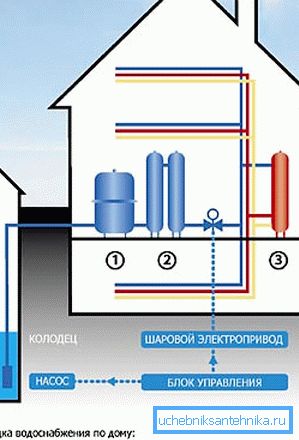
In order not to get confused, mark each element in the diagram and mark the paths of laying pipelines to the house and along it. Try to immediately draw a scheme to scale, then it will be easier for you to make this or that decision. You will understand what and how much material to buy, as well as what components will be needed for the project.
Pipe laying
Laying pipes around the house can be organized in two ways. Everyone must choose the most appropriate in their case.
Sequential
The option is suitable for owners of a small house where 1-2 people live permanently. In this case, water will flow through the whole cottage through the main pipeline.
A tee with a tap should be installed near each point of consumption. At simultaneous use of water from different taps the pressure will decrease due to low pressure in the system.

Collector
This technology provides for the supply of a separate pipe to each point of dismantling. Therefore, they will get almost the same water pressure. In this case, the loss due to the remoteness of the pumping station will be insignificant.
Although the price of this method will be higher than the previous one due to the greater amount of material and components, the result is worth it. Below we will focus on the collector scheme.
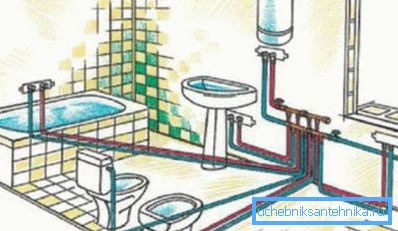
How to make the installation of water supply in the country
Pump
You can use the surface and submersible version of the pump, but the second is more convenient, since the water supply to the house from the well will be noiseless. It falls on a cable into the water, which is a natural noise insulator, and therefore cannot be heard on its surface. To the bottom of the submersible pump should not get about 800 mm, so as not to drag muddy water.
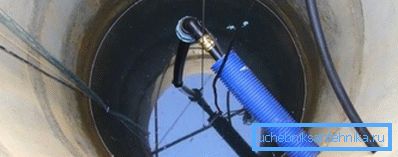
If you have chosen a submersible version of the pump for the water supply, then it will be easier for you to preserve it if necessary. Water from the system can be completely removed by opening a special solenoid drain valve.
When a surface pump is used in the plumbing system, the instruction instructs to drain it directly from the housing. So the next time you start it, you will have to fill it with water again.
Pipeline
Place the drain valve more than three meters from the surface. The water must all go through it in order not to freeze, and the underground pipeline must be laid with a slope to the source.
It can be placed not only underground, but also on the surface, if it will not be used in the winter period. Otherwise, the water supply from the well to the house in winter should take place at a depth below the freezing point of the ground or be insulated. For example, for the middle zone of our country the trench should be at least two meters deep.
Tip: When building a new home on the site, lay water pipes under the foundation.
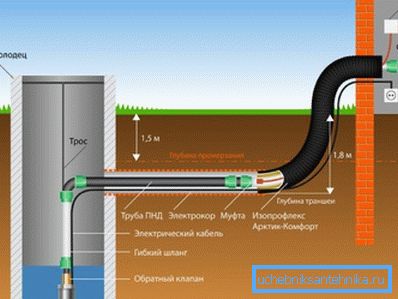
When there is no such possibility and there is also no access to the basement, it is necessary to use a superficial method of laying. One more way to protect the pipeline is to place a heating cable in it. Water will not freeze in this part of the system, preserving its efficiency even in extreme cold.
Tip: creating a plumbing system in the country, do not forget to place the pipes at an angle to the well to ensure complete drainage of water during conservation.
Additional elements
Be sure to include in the scheme of home plumbing accumulator, which will stabilize its work. It will help smooth out the differences that may occur when starting or stopping pumping equipment.
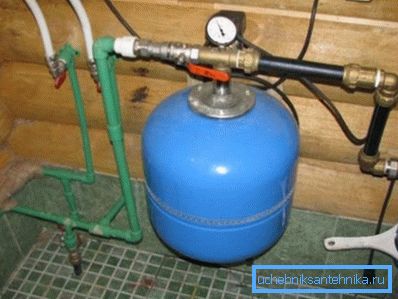
Maintain a constant pressure in the system, which should be 2.5-4 atm, for which you include a pressure switch in the circuit. A kind of fuse will serve another relay - “dry run”, which will turn off the pump when the water level drops to a critical one. Thereby saves equipment from overheating and breakage.
Provide after the accumulator a tee, which will provide a locking mechanism, it will divide the water into drinking and technical. The first should be started on the filter system for complete cleaning.
The next tee is needed to separate the stream into hot and cold water. Connect the last pipe to the manifold with shut-off valves at the points of water discharge. Move the hot water pipe to the heater, and then distribute it through the collector throughout the house. So you will have hot water in the country from the well.
Conclusion
Autonomous water supply in a country house greatly facilitates living in it. With its help, it is possible to create comfort that is not inferior to a city apartment. You only need to install and configure it correctly. In the presented video in this article you will find additional information on this topic.